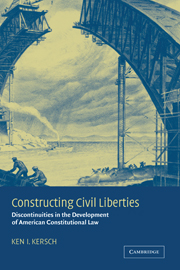3 - Reconstituting Individual Rights: From Labor Rights to Civil Rights
Published online by Cambridge University Press: 09 November 2009
Summary
Introduction
Traditional narratives of the trajectory of constitutional development concerning civil rights and liberties are quintessentially Whiggish narratives, which posit, first, the vanquishing of reactionary constitutionalism of outmoded economic liberties that characterized the premodern state of courts and parties, and, second (and coincident with the consolidation of the modern state), a linear post-breakthrough progression upward toward an increasing solicitude for personal individual liberties. This linear, progressive narrative, which is structured around barrier, breakthrough, and apotheosis, serves as an ideological adjunct of the process of legitimizing and institutionalizing the policy architecture of the New American State. In its unidimensional developmental structure, however, this narrative has worked systematically to erase the choices that were made in the ongoing process of constructing that state between contentious, agonistic creedal commitments and multiple institutional orders. Instead, as part of the process of inventing the New Constitutional Nation, it has worked systematically to construct those choices and settlements as a monistic triumph of principle.
In this chapter, I spotlight some of the key erasures that have helped to consolidate the Whiggish developmental narrative by focusing on two major – indeed, central – areas of twentieth-century constitutional reform that are typically treated separately: labor rights and civil rights. To say they are treated separately, however, is perhaps not quite right. In traditional narratives of constitutional development, the paths of development of labor rights and civil rights are treated sequentially, and, indeed, these sequential reforms constitute the spine of these unidimensional Whiggish narratives.
- Type
- Chapter
- Information
- Constructing Civil LibertiesDiscontinuities in the Development of American Constitutional Law, pp. 134 - 234Publisher: Cambridge University PressPrint publication year: 2004



